
Winter Tree Walk
Winter is coming, revealing the bones of the landscape. Wrapped by ribbons of soft mist or with edges sharp and clean in crystalline air, the trees rest. Norfolk’s trees are a vital part of our landscape and play a vital role in sustaining and protecting wildlife throughout the cold, dark months. Getting outside is an uplifting way to embrace the season and learn more about the natural world we all depend upon.
Chosen as a filming location for BBC’s Springwatch, Pensthorpe’s staggering 700-acre site includes imaginative gardens and a species-rich nature reserve of wetlands and hedgerows, woodland and riverbanks where the chalky River Wensum, flows through. It’s a lot to take in, so pull on some warm wellies and join a stunning winter walk in the company of an expert warden. It’s rather satisfying to prepare for the walk by tucking into a fortifying meal at the Courtyard Café, built on the site of an early medieval church. Then head out and discover diverse native trees like oak and birch, which provide wildlife corridors linking woodland habitats even when their leaves have fallen in autumn. One of winter’s many joys is seeing the wonderful wildlife chasing warmth and food, migrating to Norfolk from countries much icier than ours.
Don’t forget to visit the fabulous shop full of unique gifts for nature lovers and artisanal food and drink to take home for tea. And there’s a bus stop at the entrance, so if you can, go car free.
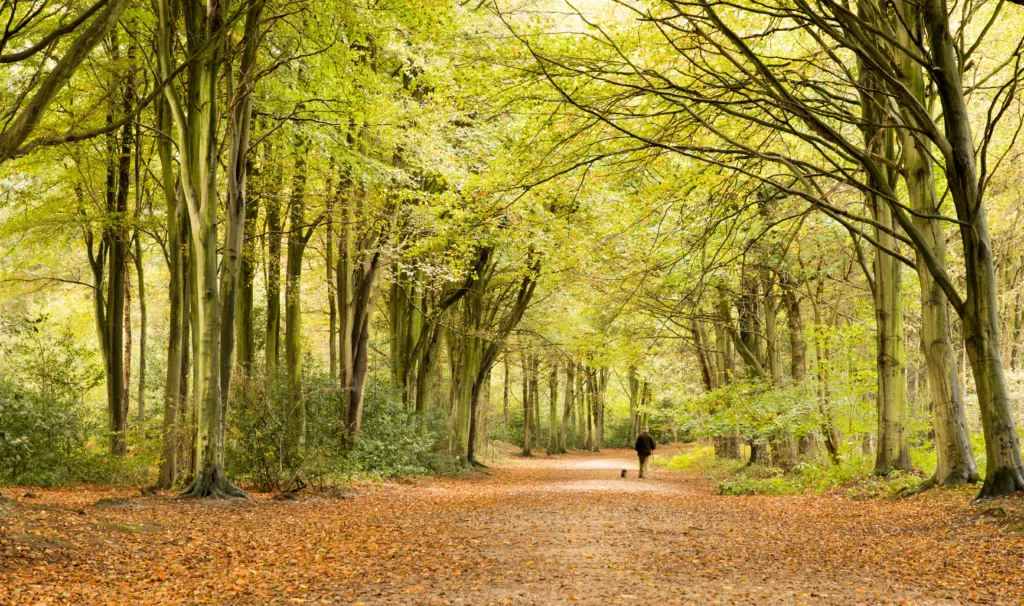
Bacton Wood
Escape into a dog-friendly woodland maze of trails for walking, jogging, cycling, orienteering and horse-riding, co-existing in pretty mixed woodland. There are over 30 species of tree including Scots and Corsican Pine, Western Hemlock, Douglas Fir and Larch. The Larch is particularly stunning in early March with its new needles of vivid, almost neon green.
Can you hear a rising melodious call from the pines? It might be a goldcrest. Spotting them is hard, as they are the smallest European bird, weighing only 5g, the same as a 20p coin. If there’s a gold stripe on its head, that’s a good indication you’ve found one!
There are few things as magical as eye contact with a deer in a misty glade at dawn on a May morning. Plenty roam the wood so you may well come across one, especially early or late in the day when they venture from the trees to feed on the grass along the rides. You’ll find Bacton Wood just north of North Walsham. It’s an idyllic place to spend the day immersed in the mood-boosting sights and sounds of nature. There are three walking trails to explore. Red, blue and also a yellow trail with an accessible surfaced route and frequent benches. Take a breather, close your eyes and listen to the whispering leaves and birdsong. Or you may prefer walking off the beaten track to discover the wood at your own sweet will.

Bird Watching in Stiffkey Wood
The small North Norfolk coastal village of Stiffkey nestles between saltmarsh and deep river valley, reminiscent of Devon. A narrow band of woodland clings to the last vestiges of dry land before the saltmarsh stretches towards the sea. Stunted and aged by winter gales and salty winds the trees are battered, facing northerly lands. They are often the first landfall Norfolk’s world famous bird migrations in Spring and Autumn, when yellow browed warblers, shrikes and firecrests, blow in on winds from the east and north. Other species, like the woodcock, wait until the right moon. Author Henry Williamson lived in the village and wrote about the woodcock’s annual arrival to Stiffkey Wood.
‘It would be pleasant to be a bird-watcher for a year: to wander thoughtless through the calm sequent days of summer’s ending: mist at morning: pallid disc of sun: windless heat and light of pale blue heaven and yellow line of sand dimming to the small red smoulder of sunset: the strings of tired birds, arriving over the sea, and settling at once on the marshes and in the low sand-dunes.
Day after day of windless calm and of sunlight, serene and warm, as though all life were suspended on earth, save for the movement of wave and tide, the piping and passing of birds. The early autumnal days were the most beautiful for that soon the sea would be black, with white lines on shoal and sandbank, while the tractor driver on the hills fastened the sack closer round his waist, against the bitter winds. Soon through the mists would float the woodcock moon, pale and circular; and with the north-east wind would come those strange birds, with dead-leaf mottle plumage and long beaks and gentle brown eyes, flapping across the North Sea, from the forests of Norway, and the stone walls of cold fields above fiords in whose green, glissading depths great salmon moved to their spawning beds.
Soon the wind would arise, and the woodcock flights over the sea begin. Singly and twos and threes, while the moon moved up the sky wind-burnished and bright, with purple shine about its winter beginning, the woodcock would come darkly over the waves.’
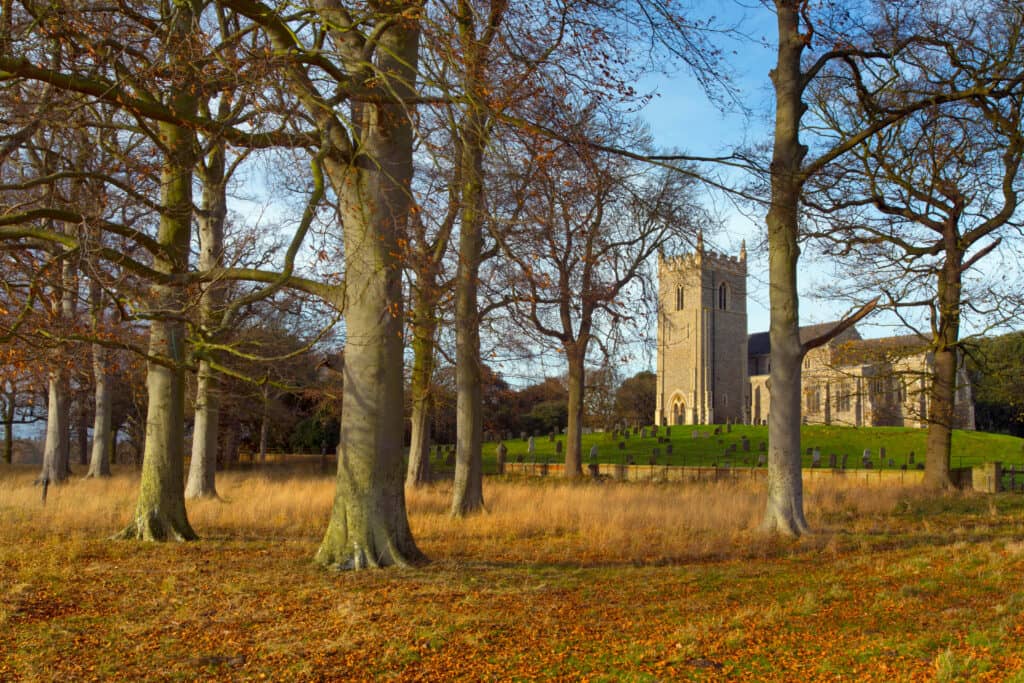
Holkham Park
The rising of the sun and the running of the deer…the idyllic landscape of Holkham and its magnificent Hall is a quintessential 18th century vision of England. Blending natural land with cultivated garden, the rolling green vistas were designed by William Kent, whose principle was ‘nature abhors a straight line’. Drawing from Nero’s Golden Palace in Rome, Ancient Greece and Egypt, the grounds and house express classical Palladian influences, with restrained architecture surrounded by parkland of grass meadows and woods, similar to a medieval deer park. Park making was all the rage in the 18th century, with new ones appearing all over the country, often incorporating a folly, temple, ilex grove, archway, tumbling stream or lake sparkling in the distance, particularly popular in Norfolk where over one hundred landscape parks were shown on Faden’s map of 1797.
Enter the gates and instead of heading along the single-track road towards the Hall, try turning left. Follow the path along the edge of the park, through woods of oak, horse chestnut and beech, framing the Holkham Hall like a landscape painting. You may come across fallow deer, lifting their dark eyes to meet your gaze, or green woodpeckers rattling out a laughing call. If you look very carefully, you might spot a tree creeper, climbing mouse-like up vertical tree boughs.
When evening light slants low through the trees, head for the Victoria Inn’s warmth and settle in for fine food, red wine and a long winter night.
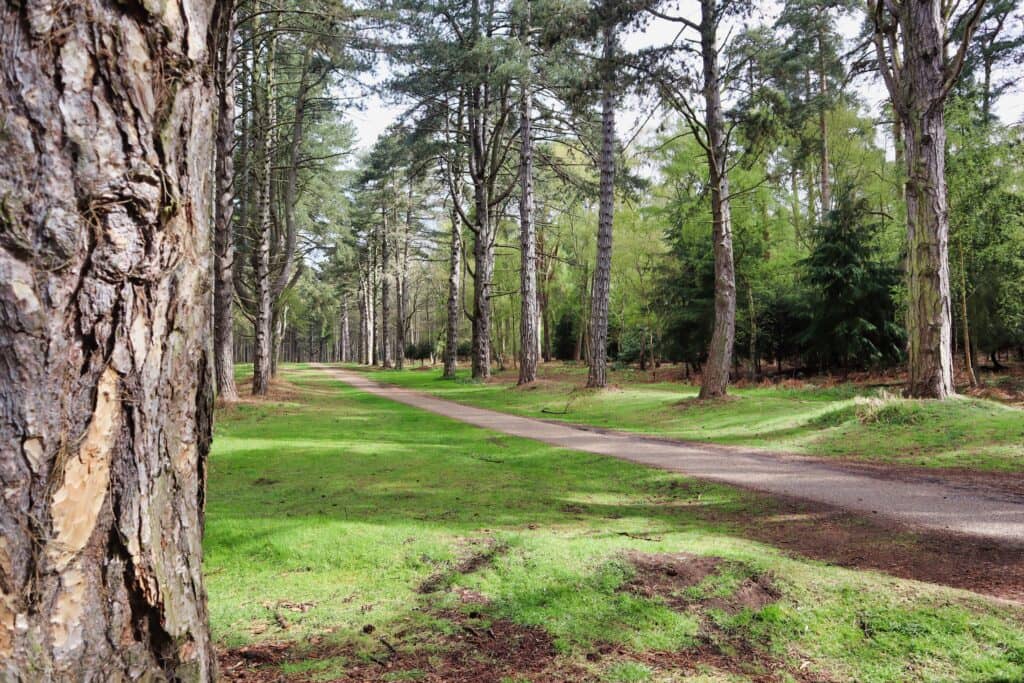
Woodland Journey
Sandringham is a right royal abode. Most royal residences, such as Buckingham Palace and Windsor Castle are owned by the Crown, but Sandringham is the personal property of the King. For decades the Queen celebrated the royal family Christmas in Norfolk and in 1957 broadcast her first televised Christmas message from her Sandringham home.
As the Queen’s favourite festive bolthole, the house, gardens and church are sometimes off limits, but the 600 acres of stunning royal parkland and fantastic courtyard facilities stay open year round, a fabulous destination for winter walks. Worries fade when you wander in the woods. Majestic trees soar upwards, an uplifting cathedral of Scots and Corsican pines rising from banks of dark glossy rhododendrons. Among them, twisted oaks, sweet chestnuts and birches are ancient relics of Norfolk’s wild landscape before forests were managed.
Breathe in the earthy scents and listen closely. Squirrels rustle in falling leaves, there’s the rat-a-tat-tat of a spotted woodpecker and maybe a creeping nut hatch pecking away on a branch. High in the white winter sky lonesome red kites are mewing and the sighing wind gives elegant winter trees a haunting music of their own.
There are two way-marked trails along tarmac and shingled paths, ideal for exploring by wheelchair or mobility scooter, and many more dog-friendly unmarked paths to walk or cycle. After a good stroll in the fresh air, head back to the visitor centre for tea, cake and Sandringham’s famous heritage apple juices.
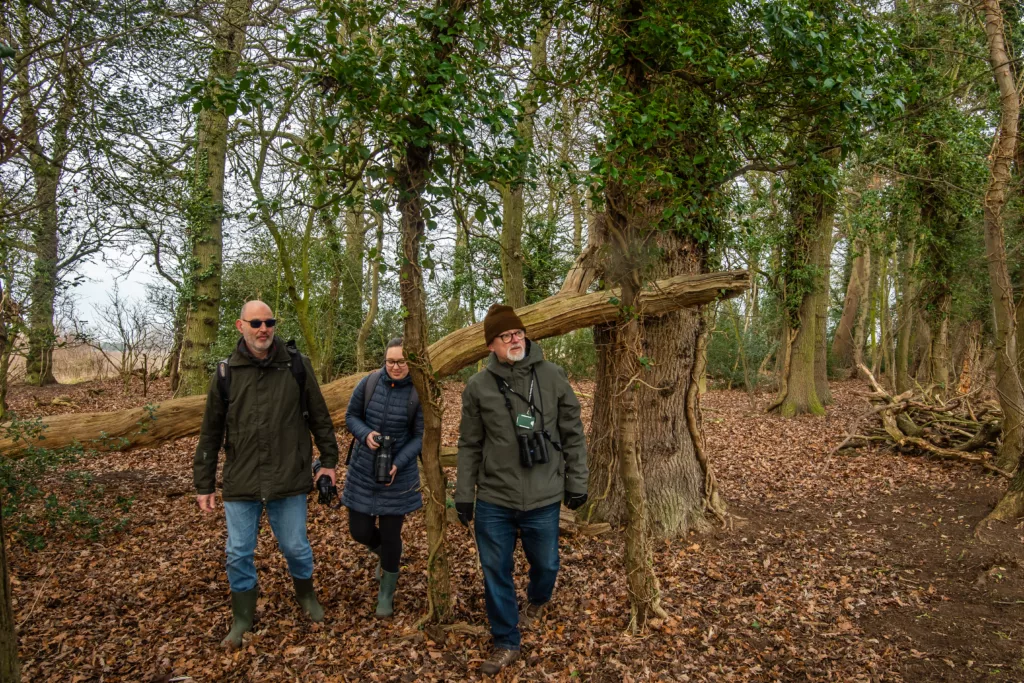
The Legend of Babes In Wayland Wood
Once upon a time all England was covered by an untamed, tangled forest. Now only pockets of ancient Wild Wood remain and to walk in them is like stepping back in time. One, mentioned in the Domesday Book, is Wayland Wood in south Norfolk. From April bluebells cover the ground amid hornbeam, oak, hazel, bird-cherry and field maple. Yellow archangel, water avens, wood anemone, early purple orchid and the rare yellow star of Bethlehem have all been found here. It’s an immensely pretty place for walks in early spring.
But in winter a more menacing atmosphere takes hold. Wayland Wood is the setting for the ‘Babes in the Wood’ and a winter walk brings the dark legend alive. An orphaned brother and sister were left in the care of their uncle at nearby Griston Hall. Should they die, this villain would inherit their father’s fortune so in the dead of winter he took them deep into Wayland Wood and abandoned them. When death came, a robin covered their frozen bodies with leaves. It’s said their little ghosts wander the wood, wailing in the dark. The oak tree where they died, huddled together, was struck by lightning in 1879.
Inside the half light of folk stories a local truth often hides. Were the babes real? Wayland Wood keeps its secrets in the shadow of oak, ash and thorn. And the Watton town sign remembers them, two shivering children under an oak tree, waiting for help that never came.
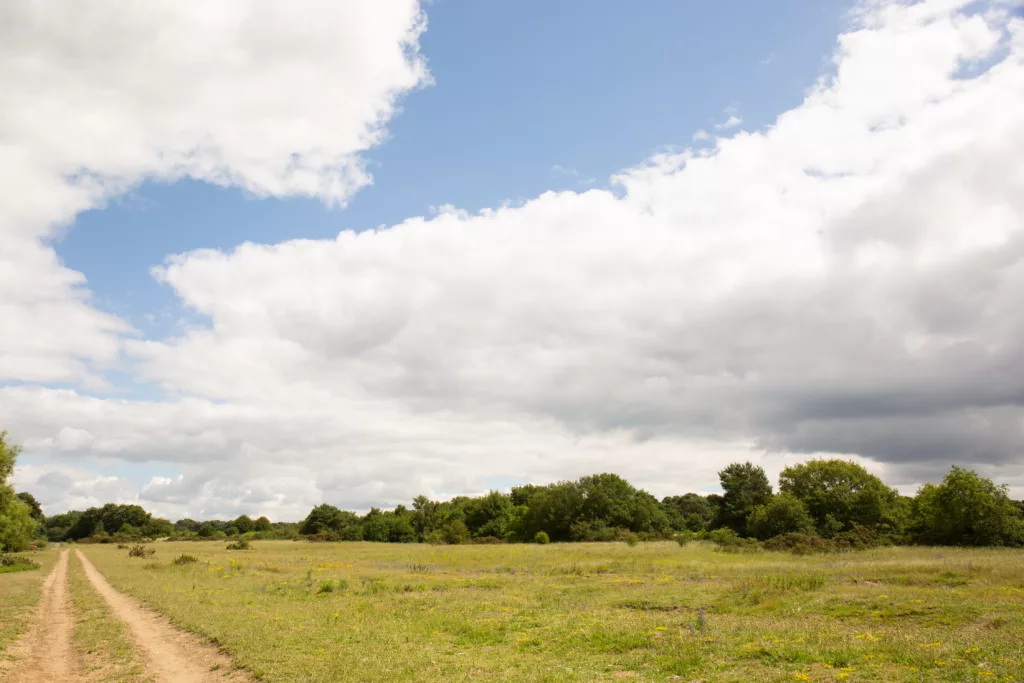
A Breckland Heath
After the First World War the British Government kicked off a massive national drive to plant huge blocks of coniferous trees for secure supplies of home-grown timber.
The sweeping sandy heathlands of the Brecks were no use for farming, good only for grazing sheep and rabbits. But they were prime real estate for millions of trees. Planting began around Thetford, eventually transforming the open grasslands to huge tracts of forest. First cleared by prehistoric farmers, wild expanses of the original heathland are rare and very special to explore.
Of the 12,550 wildlife species in the Brecks, 30% are nationally rare and some can be found only on these unique heaths. Just over the border in Suffolk is Knettishall Heath, and Norfolk’s Brettenham Heath is a 200-hectare National Nature Reserve, on chalk bedrock, tens of metres thick, laid down during the Cretaceous period.
In some places the rock is close to the surface, breaking through the sandy soil. Where the soil is thicker it also becomes slightly more acidic, subtly changing the variety of plants and wildlife. This part of Norfolk was free of ice during the most recent glacial period resembling a treeless northern tundra or steppe. Part of a mosaic of heaths, forests and farmland, Brettenham is a beautiful place for a winter walk. And if you love Geology, head for the central and eastern part of the heath, where one of the country’s best examples of acid soil and polygons of chalk can be seen.

Tea Walk at Brandon Park
How peaceful to take deep, slow breaths wandering among the tall pines of Brandon Country Park! Forest bathing, or shinrin-yoku, is the ancient Japanese practice of walking slowly and intentionally in the woods, absorbing their quiet healing powers. Cool, lemony pine is a particularly calming fragrance for mind, body and spirit. So good you could drink it! We’re not even joking…herbalists and indigenous peoples have been brewing pine needle tea for centuries. It’s the perfect natural remedy for winter sniffles, a known decongestant and expectorant with anti-inflammatory and antimicrobial properties to boot!
So take a thermos flask of boiled water on woodland walks and you’ll be ready for an impromptu foraged brew!
The Eastern White Pine (Pinus strobus) makes fabulous tea and is easily identified by clusters of 5 long needles growing brush-like from each branch. WARNING! Some conifers are toxic to humans so, as with all foraging, be 100% certain you’re taking the needles from the right kind of tree and don’t leave room for any doubt.
Once you’re sure it’s safe, gather your needles and perch on a sheltered tree stump to rustle up a brew. Here’s how:
- take a fist full of clean, green pine needles
- snip them into small pieces (discard the brown bit holding the cluster together)
- Steep the chopped needles covered by 2 cups of boiled water (take a thermos flask)
- Leave 10-15 minutes
Strain, sweeten with honey if you fancy. Thank the trees. Breathe deeply. And enjoy.
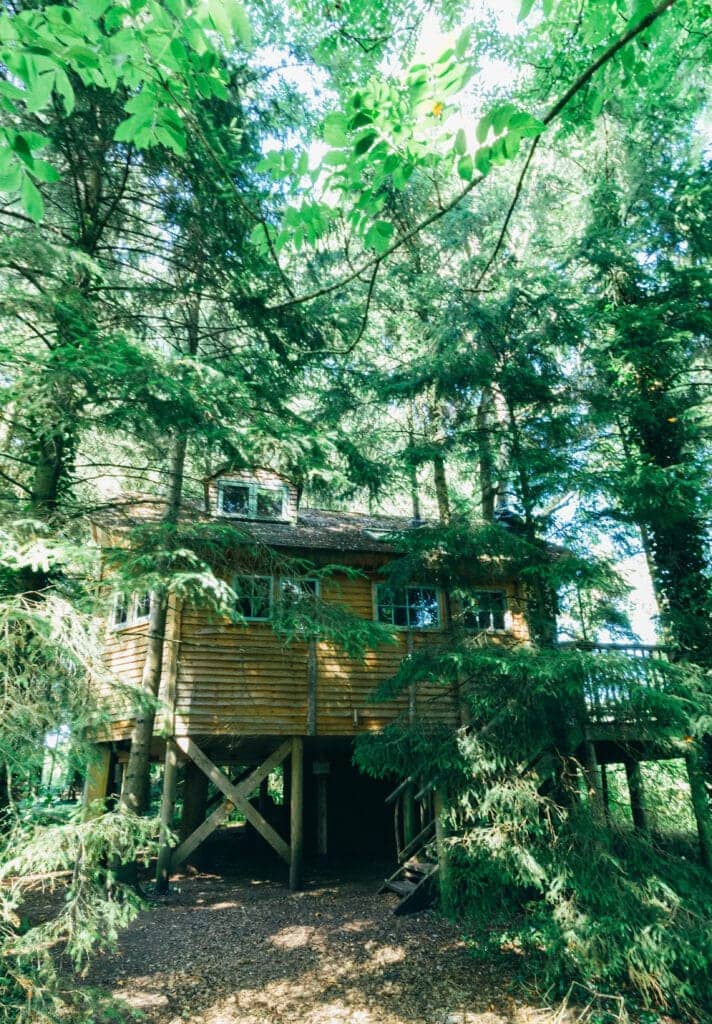
Stay in a Treehouse
Life moves pretty fast. Wouldn’t you like slow it down once in a while? Simplify the To Do List and just: relax, unwind, explore. All you need is the magic of West Lexham.
Discover a luxurious, alternative range of glamping accommodation stretched across 21 acres of lush garden, woodland, lake and river. Your home-from-home could be a boutique bell tent on the shore of a lake, cool, quirky cabin or peaceful treehouse in the leafy embrace of a forest. West Lexham’s eco-friendly paradise is perfect for back-to-nature adventure holidays and enchanting escapes for couples seeking some very special together time. Each bewitching treehouse is as different and full of character as the trees it sits among, blending rustic boho design with the finest contemporary comforts.
West Lexham is a spellbinding, healing environment that’s all about connection, nurture, creativity and transformation. It’s not just an Instagrammable place to sleep. West Lexham is a holistic retreat, snuggled down in an idyllic river valley alive with majestic ancient trees, abundant wildlife and nights full of stars.
To nourish your body the Manor gardens provide fresh seasonal produce for the restaurant, and the innovative kitchen team will get your jaded old taste buds tingling again. Almost entirely powered by renewables, West Lexham a place to unplug, unwind and recharge, away from the world’s noise and mayhem. Chill and wander with nature as you find your own little corner of calm to reflect, breathe and just be. Bliss.
Build your own itinerary
If you fancy creating your own itinerary for a day trip to Norfolk or a longer visit, it couldn’t be simpler. Just go to Search Activities and select from our wide range of free and paid-for experiences, saving any that capture your imagination with the click of a button.
Once you’ve finished, you’ll find all the information stored in My Favourite, where you can drag and drop activities to create your own day-by-day itinerary! You can download this to a calendar and even share it with friends.
